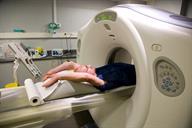CT Scan in Adults: What to Expect

A CT scan (computed tomography scan) is an imaging scan. It uses X-rays and a computer to make detailed pictures of different areas inside the body. A CT scan can give more information than a regular X-ray exam. A CT scan provides data about internal organs, soft tissue structures, blood vessels, and bones.
In this procedure, the pictures will be taken in a large machine that has an opening (CT scanner). Depending on the type of exam, a substance called contrast dye may be used to help see the area in the body that is being checked. The contrast may be swallowed, injected through an IV, or in some cases, given by an enema. An enema is when the dye is put into your colon through your anus.
Tell a health care provider about:
-
Any allergies you have.
-
All medicines you are taking, including vitamins, herbs, eye drops, creams, and over-the-counter medicines.
-
Any bleeding problems you have.
-
Any surgeries you have had.
-
Any medical conditions you have or recent illnesses.
-
Whether you are pregnant or may be pregnant.
What are the risks?
Your health care provider will talk to you about risks. These may include:
What happens before the procedure?
-
Follow instructions from your health care provider about what you may eat and drink. If contrast dye will be used for the CT scan, you may need to stop eating and drinking for a few hours before the procedure.
- Ask your health care provider about:
Changing or stopping your regular medicines. These include any diabetes medicines or blood thinners you take.
Taking over-the-counter medicines, vitamins, herbs, and supplements.
-
Remove any jewelry or metal objects.
-
Wear loose, comfortable clothing. You may be asked to change into a hospital gown.
What happens during the procedure?
-
An IV tube may be inserted into one of your veins.
-
The contrast dye will be given, if needed.
-
You will lie on a table.
-
Pillows and straps may be used to position you.
-
The table you will be lying on will move into the CT scanner.
-
You will be able to see, hear, and talk to the person running the machine while you are in it. Follow that person's instructions. You may be asked to hold your breath.
-
The CT scanner will move around you to take pictures. Do not move while it is scanning. Staying still helps the scanner to get a good image.
-
When the best possible pictures have been taken, the machine will be turned off. The table will be moved out of the machine.
-
The IV tube will be removed.
The procedure may vary among health care providers and hospitals.
What can I expect after the procedure?
Summary
-
A CT scan is an imaging scan.
-
A CT scan uses X-rays and a computer to make detailed pictures of different areas inside your body.
-
Follow instructions from your health care provider about what you may eat and drink.
-
Depending on the type of exam, a substance called contrast dye may be used to help see the area of the body being checked.
-
You will be able to see, hear, and talk to the person running the machine while you are in it. Follow that person's instructions.
This information is not intended to replace advice given to you by your health care provider. Make sure you discuss any questions you have with your health care provider.
